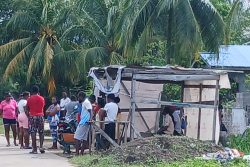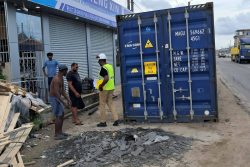Centerpiece
The anticipations of the 2014 budget are over. The Minister of Finance delivered the intention of the government to create a better Guyana for all Guyanese that carries a financial tag of $220 billion. Very few persons are surprised to see that the government plans to expand expenditure in infrastructural development which has been the centerpiece of its development effort. Even though the goals that the government plans to pursue are essentially the same as they were last year and for several years now, they will cost five per cent more than they did last year. But the budget is more than the numbers laid bare before the nation. It is also a tool for assessing performance, pointing one in the direction of corrective action and persuading people to support the various initiatives.
In the review undertaken by the Minister, several pillars on which current growth is taking place are very shaky. The export revenues have declined as a consequence of the decline in price of most major exports and the troubling condition of the sugar industry. Remittances have declined as job markets overseas remain tight. Foreign investment has declined with the decline in profit margins in the gold industry causing potential investors to cut back on their investments. The corrective action proposed for the struggling sugar industry does nothing to tackle the technical and other operational difficulties facing GuySuCo. There is still no comprehensive energy plan and there was nothing to reassure Guyanese that their confidence in the Guyana Police Force could increase. The government continues to spend money on special projects such as the Women-of-Worth project without providing evidence that they are working.
Context and environment
But even as the numbers in the budget are evaluated, attention must also be paid to the context and the environment in which this budget was presented. While not as accusatory as the 2013 budget, it introduces selectivity in the process with the offer of an education grant. Also, the budget proposal reflects still the stubborn and inflexible character of the government. The administration has shown no appetite for compromise with its unwillingness to accept that there is a new reality in which legislative business is to be conducted and governance is to take place. This refusal to accept the change is evident in the sleight-of-hand reference to the new reality which the Minister said was “styled by some a new dispensation.” With this reference, the government does not accept that anything has changed and this disposition is reflected in the many policy lines.
Unreasonable
Not only is this position unreasonable, it is also somewhat paradoxical when compared to the challenge laid down by the government to fellow Guyanese. In paragraph 4.4, on page 17 of the Minister’s statement or page 25 of the online version, the government is asking the citizens in their various roles to change their attitude. It recognizes that behaviours need to change if Guyana is to make progress. Yet, in this new political dispensation, the government refuses to change its own attitude. Through this budget, the government acknowledges that it is happy to spot the speck in the eyes of others but cannot see the beam in its own.
Outcomes
In the run up to the budget presentation, this column sought to anticipate what the government would do in areas of economic and social activity that do not usually enjoy much attention. The articles addressed the issues of health, education, sanitation, parts of the infrastructure, security and justice, and spending on vulnerable groups. As noted earlier, the outcomes are not surprising. In the area of health, it was anticipated that the budget would be increased by no less than 10 per cent. The nominal increase reached 12 per cent and the real change would hover around 11 per cent. In the case of education, it was anticipated that the budget would increase nominally by nine per cent and in real terms by 5.7 per cent. The nominal increase was 12.5 per cent and in real terms could be as high as 11.6 per cent. While no spending levels were predicted for sanitation, it was a pleasant surprise to find money was specifically allocated to address the horrific mess in Georgetown, which often looks like a large landfill. One could only hope that this is not a gimmick to score cheap political points and represents a real attempt at bringing the garbage fiasco to an end. This reassurance could only come from a very strong education and awareness programme.
The expenditure on roads and bridges continues to attract large sums of money. The money to be spent on roads this year has jumped 15 per cent in nominal terms. When compared to last year’s increase of three per cent, the rise in expenditure could be seen as intriguing. Safety of travel by air and river continues to receive marginal attention. The focus is more on acquiring buildings or renovating buildings such as the international airport and on equipment for the more established air and river routes. Concern therefore remains about the safety of our air and river services on less traditional routes. It continues that the hog of the money in the vulnerable category goes to the elderly. Sporting activities for youth will also receive a sizable allocation to continue the work on the athletic track and the aquatic centre.
Unfair
One of the claims that the government has made is that the budget is the biggest ever. While that might be true, it is also possible to regard the budget proposal as unfair and unimaginative. The government has added one new measure to supplement its public assistance programme. This item is referred to as the education grant in the budget proposal. While the intent is good, the concept is bad, and could lead to a charge of unfairness and bias. Indeed when one examines the proposed education grant, it is easy to get the impression that the government misinterprets the needs and ambitions of this nation. One could even go so far as to say that the budget is thoughtless in some respects. It is true that some people will see in the education grant is the extra income. They will not see the unfairness in the proposal and the adverse way in which it could be implemented. Under this grant scheme, the $10,000 is to be given to parents of public school children. It does not matter if the parents are well off or not, as long as the child is in a public school, the parents are able to get the money.
Personal sacrifice
Yet, the low-income parent who makes the personal sacrifice and demonstrates highly commendable financial discipline to enable his or her child to get a good education from a private school is being ignored. Not only is the government selecting favourites from among Guyanese, it is actually redistributing money from such a low-income person to parents who might be richer. The irony of it all is that that deprived child at the private school might do well and end up contributing positively to this economy. This positive externality is enjoyed by those who did not make the same financial sacrifice, but enjoyed the benefit of the redistributed income. Guyana needs to stop the habit of throwing things in the budget just for the sake of scoring political points since there is a better and fairer way to support parents and school children.
Guyana can do like other countries and give a child tax credit to every qualifying family. Or return to the policy of letting each family take a tax deduction for its dependent children. If the policy is implemented through the tax code, all parents have an equal chance of benefiting. Considering that Guyana has started to reintroduce complications in the tax code with the mortgage interest credit, it is not unreasonable to add the education grant as one more item.
Unimaginative
The budget is unimaginative also. It looks as if this country is happy to give away money, but for the wrong reasons. The government knows that one of the problems plaguing this country is getting people to come to work or to stay on the job, especially jobs that pay relatively low wages. Some commentators have even recommended bringing foreign workers as a solution to the problem. While bringing foreign workers is a possible part of the solution, it is not the only or optimal solution. Overcoming the problem requires ensuring that Guyanese find jobs and are motivated to stay working to the extent that it is necessary. This is critical since unemployment among young Guyanese is very high, over 40 per cent in some instances and it gives young Guyanese a chance to develop skills. Getting people to stay on the job has been a problem faced by other countries. To overcome that problem and to reduce the overall cost of public assistance, some countries use what is known as the earned income credit. The earned income credit was found also to be a good way to reduce poverty. The budget fails to address this issue.
Nothing new
In essence, the 2014 budget proposal offers nothing new that has positive consequences for Guyanese. Through the review of the past year, there is need for concern that the economic pillars might collapse. Much will depend on how much support the economy receives from the global economic environment. It will also depend on the willingness of the government to acknowledge the new reality with which it is faced.
LUCAS STOCK INDEX
The Lucas Stock Index (LSI) declined 0.12 percent during the fourth period of trading in March 2014. The stocks of two companies were traded with a total of 40,500 shares changing hands. There were no Climbers and one Tumbler. The shares of Demerara Tobacco Company (DTC) fell 0.72 percent on the sale of 4,400 shares while the shares of Demerara Distillers Limited (DDL) remained unchanged on the sale of 36,100 shares.








